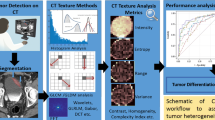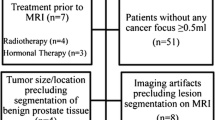Abstract
Advances in the management of genitourinary neoplasms have resulted in a trend towards providing patients with personalized care. Texture analysis of medical images, is one of the tools that is being explored to provide information such as detection and characterization of tumors, determining their aggressiveness including grade and metastatic potential and for prediction of survival rates and risk of recurrence. In this article we review the basic principles of texture analysis and then detail its current role in imaging of individual neoplasms of the genitourinary system.






Similar content being viewed by others
References
AJCC Cancer Staging Manual| Mahul B. Amin | Springer. http://www.springer.com/us/book/9783319406176 Accessed 10 Sep 2017
Siegel RL, Miller KD, Jemal A (2018) Cancer statistics, 2018. CA Cancer J Clin. 68(1):7–30
Stühler V, Kruck S, Hegemann M, et al. (2017) TKI 2.0—Wandel in der medikamentösen. Therapie des Nierenzellkarzinoms Urol. 6:1–7
Aragon-Ching JB (2014) The Evolution of Prostate Cancer Therapy: Targeting the Androgen Receptor. Front Oncol 4:295
Martyn-Hemphill C, Mak D, Khan MS, Challacombe BJ, Bishop CV (2013) Recent advances in diagnosis and treatment of transitional cell carcinoma of the bladder. Int J Surg. 11(9):749–752
Einhorn LH (2002) Curing metastatic testicular cancer. Proc Natl Acad Sci USA. 99(7):4592–4595
Mazurowski MA (2015) Radiogenomics: What It Is and Why It Is Important. J Am Coll Radiol. 12(8):862–866
Giardino A, Gupta S, Olson E, et al. (2017) Role of Imaging in the Era of Precision Medicine. Acad Radiol. 24(5):639–649
Hellbach K, Sterzik A, Sommer W, et al. (2017) Dual energy CT allows for improved characterization of response to antiangiogenic treatment in patients with metastatic renal cell cancer. Eur Radiol. 27(6):2532–2537
Verma S, Rajesh A, Morales H, et al. (2011) Assessment of Aggressiveness of Prostate Cancer: Correlation of Apparent Diffusion Coefficient With Histologic Grade After Radical Prostatectomy. Am J Roentgenol. 196(2):374–381
Ledley RS, Huang HK, Rotolo LS (1975) A texture analysis method in classification of coal workers’ pneumoconiosis. Comput Biol Med. 5(1):53–67
Kotter E, Langer M (2011) Computer aided detection and diagnosis in radiology. Eur Radiol. 21(3):590–592
Castellano G, Bonilha L, Li LM, Cendes F (2004) Texture analysis of medical images. Clin Radiol. 59(12):1061–1069
Chen CH, Pau LF, Wang PSP (1993) Handbk of Pattern Recognition. Singapore: World Scientific Publishing Company, p 996
Lubner MG, Smith AD, Sandrasegaran K, Sahani DV, Pickhardt PJ (2017) CT Texture Analysis: Definitions, Applications, Biologic Correlates, and Challenges. RadioGraphics. 37(5):1483–1503
Haralick RM, Shanmugam K, Dinstein I (1973) Textural Features for Image Classification. IEEE Trans Syst Man Cybern SMC-3(6):610–621
Mayerhoefer ME, Szomolanyi P, Jirak D, Materka A, Trattnig S (2009) Effects of MRI acquisition parameter variations and protocol heterogeneity on the results of texture analysis and pattern discrimination: An application-oriented study. Med Phys. 36(4):1236–1243
Bashir U, Siddique MM, Mclean E, Goh V, Cook GJ (2016) Imaging Heterogeneity in Lung Cancer: Techniques, Applications, and Challenges. Am J Roentgenol. 207(3):534–543
Kassner A, Thornhill RE (2010) Texture Analysis: A Review of Neurologic MR Imaging Applications. Am J Neuroradiol. 31(5):809–816
Kim JY, Kim JK, Kim N, Cho K-S (2008) CT Histogram Analysis: Differentiation of Angiomyolipoma without Visible Fat from Renal Cell Carcinoma at CT Imaging. Radiology. 246(2):472–479
Kim JK, Kim SH, Jang YJ, et al. (2006) Renal Angiomyolipoma with Minimal Fat: Differentiation from Other Neoplasms at Double-Echo Chemical Shift FLASH MR Imaging. Radiology. 239(1):174–180
Hodgdon T, McInnes MDF, Schieda N, et al. (2015) Can Quantitative CT Texture Analysis be Used to Differentiate Fat-poor Renal Angiomyolipoma from Renal Cell Carcinoma on Unenhanced CT Images? Radiology. 276(3):787–796
Lee HS, Hong H, Jung DC, Park S, Kim J (2017) Differentiation of fat-poor angiomyolipoma from clear cell renal cell carcinoma in contrast-enhanced MDCT images using quantitative feature classification. Med Phys. 44(7):3604–3614
Lubner MG, Stabo N, Abel EJ, Del Rio AM, Pickhardt PJ (2016) CT Textural Analysis of Large Primary Renal Cell Carcinomas: Pretreatment Tumor Heterogeneity Correlates With Histologic Findings and Clinical Outcomes. AJR Am J Roentgenol. 207(1):96–105
Haider MA, Vosough A, Khalvati F, et al. (2017) CT texture analysis: a potential tool for prediction of survival in patients with metastatic clear cell carcinoma treated with sunitinib. Cancer Imaging. 17:4
Schieda N, Thornhill RE, Al-Subhi M, et al. (2015) Diagnosis of Sarcomatoid Renal Cell Carcinoma With CT: Evaluation by Qualitative Imaging Features and Texture Analysis. AJR Am J Roentgenol. 204(5):1013–1023
Kierans AS, Rusinek H, Lee A, et al. (2014) Textural differences in apparent diffusion coefficient between low- and high-stage clear cell renal cell carcinoma. AJR Am J Roentgenol. 203(6):W637–W644
Pignot G, Elie C, Conquy S, et al. (2007) Survival Analysis of 130 Patients with Papillary Renal Cell Carcinoma: Prognostic Utility of Type 1 and Type 2 Subclassification. Urology. 69(2):230–235
Doshi AM, Ream JM, Kierans AS, et al. (2016) Use of MRI in Differentiation of Papillary Renal Cell Carcinoma Subtypes: Qualitative and Quantitative Analysis. AJR Am J Roentgenol. 206(3):566–572
Antunes J, Viswanath S, Rusu M, et al. (2016) Radiomics Analysis on FLT-PET/MRI for Characterization of Early Treatment Response in Renal Cell Carcinoma: A Proof-of-Concept Study. Transl Oncol. 9(2):155–162
Goh V, Ganeshan B, Nathan P, et al. (2011) Assessment of Response to Tyrosine Kinase Inhibitors in Metastatic Renal Cell Cancer: CT Texture as a Predictive Biomarker. Radiology. 261(1):165–171
Han SM, Lee HJ, Choi JY (2008) Computer-aided Prostate Cancer Detection using Texture Features and Clinical Features in Ultrasound Image. J Digit Imaging. 21(Suppl 1):121–133
Mohamed SS, Li J, Salama MMA, Freeman G (2009) Prostate Tissue Texture Feature Extraction for Suspicious Regions Identification on TRUS Images. J Digit Imaging. 22(5):503–518
Kwak JT, Xu S, Wood BJ, et al. (2015) Automated prostate cancer detection using T2-weighted and high-b-value diffusion-weighted magnetic resonance imaging. Med Phys. 42(5):2368–2378
Khalvati F, Wong A, Haider MA (2015) Automated prostate cancer detection via comprehensive multi-parametric magnetic resonance imaging texture feature models. BMC Med Imaging. 15:27
Lv D, Guo X, Wang X, Zhang J, Fang J (2009) Computerized characterization of prostate cancer by fractal analysis in MR images. J Magn Reson Imaging. 30(1):161–168
Sidhu HS, Benigno S, Ganeshan B, et al. (2017) Textural analysis of multiparametric MRI detects transition zone prostate cancer. Eur Radiol. 27(6):2348–2358
Gordetsky J, Epstein J (2016) Grading of prostatic adenocarcinoma: current state and prognostic implications. Diagn Pathol. 11:25
Nketiah G, Elschot M, Kim E, et al. (2017) T2-weighted MRI-derived textural features reflect prostate cancer aggressiveness: preliminary results. Eur Radiol. 27(7):3050–3059
Vignati A, Mazzetti S, Giannini V, et al. (2015) Texture features on T2-weighted magnetic resonance imaging: new potential biomarkers for prostate cancer aggressiveness. Phys Med Biol. 60(7):2685
Rozenberg R, Thornhill RE, Flood TA, et al. (2016) Whole-Tumor Quantitative Apparent Diffusion Coefficient Histogram and Texture Analysis to Predict Gleason Score Upgrading in Intermediate-Risk 3 + 4 = 7 Prostate Cancer. Am J Roentgenol. 206(4):775–782
Gnep K, Fargeas A, Gutiérrez-Carvajal RE, et al. (2017) Haralick textural features on T2-weighted MRI are associated with biochemical recurrence following radiotherapy for peripheral zone prostate cancer. J Magn Reson Imaging. 45(1):103–117
Reischauer C, Patzwahl R, Koh D-M, Froehlich JM, Gutzeit A (2018) Texture analysis of apparent diffusion coefficient maps for treatment response assessment in prostate cancer bone metastases—A pilot study. Eur J Radiol. 1(101):184–190
Tekes A, Kamel I, Imam K, et al. (2005) Dynamic MRI of Bladder Cancer: Evaluation of Staging Accuracy. Am J Roentgenol. 184(1):121–127
Xu X, Zhang X, Tian Q, et al. (2017) Three-dimensional texture features from intensity and high-order derivative maps for the discrimination between bladder tumors and wall tissues via MRI. Int J Comput Assist Radiol Surg. 12(4):645–656
Garapati SS, Hadjiiski L, Cha KH, et al. (2017) Urinary bladder cancer staging in CT urography using machine learning. Med Phys. 44(11):5814–5823
Woldu SL, Bagrodia A, Lotan Y (2017) Guideline of guidelines: non-muscle-invasive bladder cancer. BJU Int. 119(3):371–380
Zhang X, Xu X, Tian Q, et al. (2017) Radiomics assessment of bladder cancer grade using texture features from diffusion-weighted imaging. J Magn Reson Imaging. 46(5):1281–1288
Zhang G-M-Y, Sun H, Shi B, Jin Z-Y, Xue H-D (2017) Quantitative CT texture analysis for evaluating histologic grade of urothelial carcinoma. Abdom Radiol. 1, 42(2):561–568
Shi Z, Yang Z, Zhang G, et al. (2013) Characterization of Texture Features of Bladder Carcinoma and the Bladder Wall on MRI. Acad Radiol. 20(8):930–938
Wu S, Zheng J, Li Y, et al. (2017) A Radiomics Nomogram for the Preoperative Prediction of Lymph Node Metastasis in Bladder Cancer. Clin Cancer Res. 23(22):6904–6911
Cha KH, Hadjiiski L, Chan H-P, et al. (2017) Bladder Cancer Treatment Response Assessment in CT using Radiomics with Deep-Learning. Sci Rep. 7:8738
Lenert JT, Barnett CC, Kudelka AP, et al. (2001) Evaluation and surgical resection of adrenal masses in patients with a history of extra-adrenal malignancy. Surgery. 130(6):1060–1067
Schieda N, Krishna S, McInnes MDF, et al. (2017) Utility of MRI to Differentiate Clear Cell Renal Cell Carcinoma Adrenal Metastases From Adrenal Adenomas. Am J Roentgenol. 209(3):W152–W159
Chong S, Lee KS, Kim HY, et al. (2006) Integrated PET-CT for the Characterization of Adrenal Gland Lesions in Cancer Patients: Diagnostic Efficacy and Interpretation Pitfalls. RadioGraphics. 26(6):1811–1824
Nakajo M, Jinguji M, Nakajo M, et al. (2017) Texture analysis of FDG PET/CT for differentiating between FDG-avid benign and metastatic adrenal tumors: efficacy of combining SUV and texture parameters. Abdom Radiol. 13:1–8
Chalkidou A, O’Doherty MJ, Marsden PK (2015) False Discovery Rates in PET and CT Studies with Texture Features: A Systematic Review. PLoS ONE. 10(5):e0124165
Mackin D, Fave X, Zhang L, et al. (2015) Measuring CT scanner variability of radiomics features. Invest Radiol. 50(11):757–765
Lu L, Ehmke RC, Schwartz LH, Zhao B (2016) Assessing Agreement between Radiomic Features Computed for Multiple CT Imaging Settings. PLoS ONE. 11(12):e0166550
Shafiq-ul-Hassan M, Zhang GG, Latifi K, et al. (2017) Intrinsic dependencies of CT radiomic features on voxel size and number of gray levels. Med Phys. 44(3):1050–1062
Solomon J, Mileto A, Nelson RC, Roy Choudhury K, Samei E (2015) Quantitative Features of Liver Lesions, Lung Nodules, and Renal Stones at Multi-Detector Row CT Examinations: Dependency on Radiation Dose and Reconstruction Algorithm. Radiology. 279(1):185–194
Brynolfsson P, Nilsson D, Torheim T, et al. (2017) Haralick texture features from apparent diffusion coefficient (ADC) MRI images depend on imaging and pre-processing parameters. Sci Rep. 7:4041
Fave X, Mackin D, Yang J, et al. (2015) Can radiomics features be reproducibly measured from CBCT images for patients with non-small cell lung cancer? Med Phys. 42(12):6784–6797
Summers RM (2017) Texture analysis in radiology: Does the emperor have no clothes? Abdom Radiol. 42(2):342–345
Recht M, Bryan RN (2017) Artificial Intelligence: Threat or Boon to Radiologists? J Am Coll Radiol. 14:1476–1480
Chockley K, Emanuel E (2016) The End of Radiology? Three Threats to the Future Practice of Radiology. J Am Coll Radiol. 13:1415–1420
Wang G, Kalra M, Orton CG (2017) Machine learning will transform radiology significantly within the next 5 years. Med Phys. 44(6):2041–2044
Parmar C, Grossmann P, Bussink J, Lambin P, Aerts HJWL (2015) Machine Learning methods for Quantitative Radiomic Biomarkers. Sci Rep. 5:13087
Author information
Authors and Affiliations
Corresponding author
Ethics declarations
Funding
This review article did not receive any funding.
Conflict of interest
Dr. Shinagare has the following financial disclosures: 1. Consultant, Arog Pharmaceuticals, 2. Research funding, GTx Inc.Thomas, Qin, Alessandrino, Sahu, Guerra and Krajewski do not have any disclosures.
Ethical approval
This article does not contain any studies with human participants or animals performed by any of the authors.
Informed consent
There was no need for informed consent as this is a review article.
IRB approval
No IRB approval was necessary for this review article.
Rights and permissions
About this article
Cite this article
Thomas, R., Qin, L., Alessandrino, F. et al. A review of the principles of texture analysis and its role in imaging of genitourinary neoplasms. Abdom Radiol 44, 2501–2510 (2019). https://doi.org/10.1007/s00261-018-1832-5
Published:
Issue Date:
DOI: https://doi.org/10.1007/s00261-018-1832-5




